The plant moisture tester market is valued at USD 507.3 million in 2025 and is projected to reach USD 908.5 million by 2035, growing at a CAGR of 6.0% over the forecast period. The plant moisture tester market is set for steady expansion through 2035, supported by rising adoption of precision measurement tools across plant research institutes, coastal ecology assessment programs, and agricultural monitoring environments. Demand is driven by the need to maintain accurate moisture balance for optimized plant health, environmental stability, and research data consistency. Single-parameter instruments lead adoption, offering straightforward measurement functionality, high portability, and strong reliability for field and laboratory use cases.
Growth during 2025–2030 reflects broader standardization of environmental monitoring practices and cost-efficient sensor refinement. The 2030–2035 period shifts toward wider usage of multi-parameter devices integrated into digital monitoring networks, enabling real-time data logging and automated irrigation control. Asia Pacific demonstrates the fastest expansion due to rising investment in agricultural modernization and climate impact monitoring, while North America and Europe maintain leading roles in research-intensive applications driven by ecological conservation initiatives and regulated agriculture. Key players focus on enhancing sensor durability, soil/tissue measurement accuracy, and device connectivity. Market challenges include calibration variability across different soil compositions and pricing barriers in resource-constrained agricultural regions. However, ongoing integration with precision agriculture systems and ecological research networks sustains long-term adoption momentum.

The latter half (2030-2035) will witness steady growth from USD 679 million to USD 908.5 million, representing an addition of USD 229.5 million or 57% of the decade's expansion. This period will be defined by mass market penetration of specialized multiparameter testing designs, integration with comprehensive agricultural monitoring platforms, and seamless compatibility with existing environmental research infrastructure. The market trajectory signals fundamental shifts in how researchers approach precision agriculture optimization and environmental quality management, with participants positioned to benefit from steady demand across multiple measurement types and application segments.
The market demonstrates distinct growth phases with varying market characteristics and competitive dynamics. Between 2025 and 2030, the market progresses through its technology adoption phase, expanding from USD 507.3 million to USD 679 million with steady annual increments averaging 6.0% growth. This period showcases the transition from basic moisture measurement formulations to advanced single parameter systems with enhanced data accuracy capabilities and integrated monitoring control systems becoming mainstream features.
The 2025-2030 phase adds USD 171.7 million to market value, representing 43% of total decade expansion. Market maturation factors include standardization of environmental monitoring and agricultural research protocols, declining component costs for specialized sensor formulations, and increasing industry awareness of precision agriculture benefits reaching optimal moisture management effectiveness in plant research and coastal ecology applications. Competitive landscape evolution during this period features established instrument manufacturers like SONKIR and VIVOSUN expanding their moisture tester portfolios while specialty manufacturers focus on advanced measurement development and enhanced accuracy capabilities.
From 2030 to 2035, market dynamics shift toward advanced technology integration and global agricultural expansion, with growth continuing from USD 679 million to USD 908.5 million, adding USD 229.5 million or 57% of total expansion. This phase transition centers on specialized multiparameter measurement systems, integration with automated monitoring networks, and deployment across diverse plant research and environmental monitoring scenarios, becoming standard rather than specialized applications. The competitive environment matures with focus shifting from basic measurement capability to comprehensive data optimization systems and integration with agricultural monitoring platforms.
| Metric | Value |
|---|---|
| Market Value (2025) | USD 507.3 million |
| Market Forecast (2035) | USD 908.5 million |
| Growth Rate | 6.0% CAGR |
| Leading Technology | Single Parameter Instruments Measurement Type |
| Primary Application | Coastal Ecology Application Segment |
The market demonstrates strong fundamentals with single parameter instrument systems capturing a dominant share through advanced measurement precision and operational optimization capabilities. Coastal ecology applications drive primary demand, supported by increasing environmental research volumes and precision monitoring technology requirements. Geographic expansion remains concentrated in developed markets with established agricultural research infrastructure, while emerging economies show accelerating adoption rates driven by environmental monitoring expansion and rising precision agriculture standards.
Market expansion rests on three fundamental shifts driving adoption across the plant research, coastal ecology, and environmental research sectors. First, precision agriculture demand creates compelling operational advantages through plant moisture testers that provide immediate data accuracy and environmental monitoring without compromising measurement goals, enabling researchers to meet stringent quality standards while maintaining operational productivity and reducing resource waste. Second, environmental monitoring modernization accelerates as research facilities worldwide seek advanced measurement systems that complement traditional monitoring processes, enabling precise data collection and quality control that align with industry standards and environmental regulations.
Third, agricultural technology enhancement drives adoption from precision farming operations and environmental research organizations requiring effective monitoring solutions that maximize data accuracy while maintaining operational productivity during measurement and analysis operations. Growth faces headwinds from equipment cost challenges that vary across instrument suppliers regarding the sourcing of sensor components and calibration systems, which may limit adoption in cost-sensitive environments. Technical limitations also persist regarding calibration accuracy and environmental interference concerns that may reduce effectiveness in extreme weather and soil variability scenarios, which affect measurement performance and reliability requirements.
The plant moisture tester market represents a specialized yet critical agricultural technology opportunity driven by expanding global precision agriculture adoption, environmental monitoring modernization, and the need for superior moisture management in diverse plant research applications. As researchers worldwide seek to achieve optimal measurement accuracy, reduce resource consumption, and integrate advanced testing systems with automated platforms, plant moisture testers are evolving from basic measurement devices to sophisticated monitoring solutions ensuring agricultural productivity and environmental management leadership.
The market's growth trajectory from USD 507.3 million in 2025 to USD 908.5 million by 2035 at a 6.0% CAGR reflects fundamental shifts in agricultural industry monitoring requirements and precision agriculture optimization. Geographic expansion opportunities are particularly pronounced in Asia Pacific markets, while the dominance of single parameter instrument systems and coastal ecology applications provides clear strategic focus areas.
Strengthening the dominant single parameter instrument segment through enhanced sensor formulations, superior measurement accuracy, and automated data collection systems. This pathway focuses on optimizing measurement precision, improving monitoring capabilities, extending operational effectiveness to optimal data reliability rates, and developing specialized formulations for diverse applications. Market leadership consolidation through advanced sensor engineering and automated monitoring integration enables premium positioning while defending competitive advantages against alternative measurement technologies. Expected revenue pool: USD 105-140 million
Rapid precision agriculture and environmental research growth across Asia Pacific creates substantial expansion opportunities through local manufacturing capabilities and technology transfer partnerships. Growing agricultural modernization and government environmental monitoring initiatives drive steady demand for advanced moisture tester systems. Localization strategies reduce import costs, enable faster technical support, and position companies advantageously for procurement programs while accessing growing domestic markets. Expected revenue pool: USD 90-125 million
Expansion within the dominant coastal ecology segment through specialized measurement designs addressing environmental monitoring standards and high-volume research requirements. This pathway encompasses automated data logging systems, quality control integration, and compatibility with diverse environmental research processes. Premium positioning reflects superior measurement accuracy and comprehensive monitoring compliance supporting modern ecological research. Expected revenue pool: USD 75-105 million
Strategic expansion into plant research applications requires enhanced measurement capabilities and specialized instrument formulations addressing agricultural research operational requirements. This pathway addresses precision agriculture monitoring, crop optimization enhancement, and academic research applications with advanced sensor engineering for demanding accuracy standards. Premium pricing reflects specialized measurement requirements and extended durability standards. Expected revenue pool: USD 65-90 million
Development of specialized moisture tester formulations for environmental research applications and other segments, addressing specific monitoring requirements and niche measurement demands. This pathway encompasses hybrid designs, environmentally optimized sensors, and cost-effective alternatives for emerging agricultural segments. Technology differentiation through proprietary formulations enables diversified revenue streams while reducing dependency on single application platforms. Expected revenue pool: USD 55-75 million
Expansion of multiparameter instrument segment through enhanced measurement versatility, comprehensive data collection properties, and specialized research monitoring requirements. This pathway encompasses advanced agricultural applications, laboratory-grade environmental products, and specialty formulations requiring superior measurement quality characteristics. Market development through advanced sensor engineering enables differentiated positioning while accessing premium markets requiring highest-quality testing solutions. Expected revenue pool: USD 50-70 million
Development of environmentally superior moisture tester formulations addressing regulatory compliance and sustainability requirements across plant research and coastal ecology applications. This pathway encompasses recycled material integration, ecofriendly manufacturing processes, and comprehensive ecological documentation. Premium positioning reflects environmental leadership and ecofriendly expertise while enabling access to environmentally-focused procurement programs and sustainability-driven research partnerships. Expected revenue pool: USD 45-60 million
Primary Classification: The market segments by measurement type into Single Parameter Instruments and Multiparameter Instruments categories, representing the evolution from basic measurement devices to comprehensive testing solutions for agricultural optimization.
Secondary Classification: Application segmentation divides the market into Coastal Ecology, Plant Research, Environmental Research, and Others sectors, reflecting distinct requirements for measurement accuracy, monitoring capacity, and data collection standards.
Regional Classification: Geographic distribution covers Asia Pacific, Europe, North America, and other regions, with developed markets leading adoption while emerging economies show accelerating growth patterns driven by precision agriculture expansion programs.
The segmentation structure reveals technology progression from standard sensor-based formulations toward specialized measurement systems with enhanced accuracy and data capabilities, while application diversity spans from coastal ecology monitoring to specialized plant research and environmental applications requiring precise moisture testing solutions.

Market Position: Single parameter instrument systems command the leading position in the market with approximately 58.0% market share through advanced measurement properties, including superior sensor accuracy, operational simplicity, and cost optimization that enable researchers to achieve optimal moisture monitoring across diverse plant research and environmental monitoring environments.
Value Drivers: The segment benefits from researcher preference for reliable measurement systems that provide consistent monitoring performance, reduced operational complexity, and data accuracy without requiring significant equipment modifications. Advanced sensor features enable portable field testing, measurement consistency, and integration with existing research equipment, where instrument performance and operational reliability represent critical research requirements.
Competitive Advantages: Single parameter instrument systems differentiate through proven measurement stability, consistent data characteristics, and integration with manual monitoring systems that enhance operational effectiveness while maintaining optimal accuracy suitable for diverse agricultural research applications.
Key market characteristics:
Multiparameter instrument systems maintain an expanding market positioning in the market with approximately 42.0% market share due to their comprehensive measurement properties and advanced monitoring advantages. These systems appeal to researchers requiring sophisticated measurement capabilities with enhanced data collection for comprehensive environmental analysis applications. Market adoption is driven by advanced research facility expansion, focusing integrated monitoring solutions and operational versatility through optimized multiparameter sensor systems while maintaining competitive pricing structures.
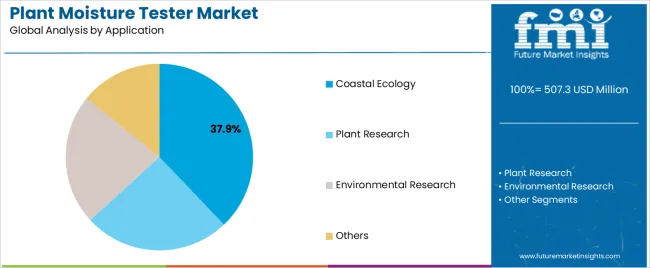
Market Context: Coastal ecology applications dominate the market with approximately 37.9% market share due to widespread adoption of precision moisture monitoring and increasing focus on environmental conservation, habitat management, and ecosystem research applications that minimize monitoring failures while maintaining environmental research standards.
Appeal Factors: Coastal ecology researchers prioritize measurement reliability, data consistency, and integration with existing environmental monitoring infrastructure that enables coordinated testing application across multiple research sites. The segment benefits from substantial environmental research investment and conservation programs that emphasize the acquisition of moisture testing equipment for ecosystem monitoring and habitat preservation applications.
Growth Drivers: Coastal ecosystem preservation programs incorporate plant moisture testers as standard measurement tools for environmental monitoring operations, while climate change research expansion increases demand for precision monitoring capabilities that comply with environmental standards and minimize data inconsistencies.
Market Challenges: Varying environmental research standards and coastal habitat differences may limit measurement standardization across different monitoring locations or operational scenarios.
Application dynamics include:
Plant research applications capture approximately 23.9% market share through specialized measurement requirements in agricultural research facilities, botanical study operations, and academic plant science applications. These facilities demand reliable moisture testing systems capable of providing accurate soil and plant tissue measurements while enabling comprehensive agricultural optimization and research data collection capabilities.
Environmental research applications account for approximately 14.4% market share, while other segments capture 23.8%, including horticultural monitoring, greenhouse operations, and specialized agricultural applications requiring moisture testing capabilities for precision farming and crop management.
Growth Accelerators: Precision agriculture expansion drives primary adoption as plant moisture testers provide superior monitoring capabilities that enable agricultural researchers to meet stringent data accuracy standards without excessive equipment costs, supporting research operations and environmental monitoring missions that require precise moisture measurement applications. Environmental monitoring infrastructure demand accelerates market expansion as research facilities seek effective measurement systems that minimize resource waste while maintaining operational effectiveness during field testing and data collection scenarios. Agricultural technology spending increases worldwide, creating steady demand for precision monitoring systems that complement traditional farming processes and provide operational optimization in competitive markets.
Growth Inhibitors: Equipment cost challenges vary across instrument suppliers regarding the sourcing of sensor components and calibration systems, which may limit operational flexibility and market penetration in regions with constrained research budgets or cost-sensitive agricultural operations. Technical performance limitations persist regarding calibration accuracy and environmental interference concerns that may reduce effectiveness in extreme temperature, humidity, or electromagnetic conditions, affecting measurement reliability and data quality requirements. Market fragmentation across multiple agricultural research standards and environmental monitoring protocols creates compatibility concerns between different instrument suppliers and existing monitoring infrastructure.
Market Evolution Patterns: Adoption accelerates in coastal ecology and plant research sectors where data accuracy justifies equipment costs, with geographic concentration in developed markets transitioning toward mainstream adoption in emerging economies driven by agricultural modernization and environmental research awareness. Technology development focuses on enhanced sensor formulations, improved wireless connectivity integration, and compatibility with automated data logging systems that optimize measurement accuracy and monitoring effectiveness. The market could face disruption if alternative moisture measurement technologies or remote sensing innovations significantly limit the deployment of handheld testers in agricultural applications, though direct contact measurement's unique combination of accuracy, portability, and cost-effectiveness continues to make it preferred in field research applications.
The market demonstrates varied regional dynamics with Growth Leaders including China (8.1% CAGR) and India (7.5% CAGR) driving expansion through agricultural modernization capacity additions and precision farming programs. Steady Performers encompass Germany (6.9% CAGR), Brazil (6.3% CAGR), and United States (5.7% CAGR), benefiting from established agricultural research industries and advanced environmental monitoring adoption. Mature Markets feature United Kingdom (5.1% CAGR) and Japan (4.5% CAGR), where specialized precision agriculture applications and research monitoring integration support consistent growth patterns.

| Country | CAGR (2025-2035) |
|---|---|
| China | 8.1% |
| India | 7.5% |
| Germany | 6.9% |
| Brazil | 6.3% |
| United States | 5.7% |
| United Kingdom | 5.1% |
| Japan | 4.5% |
Regional synthesis reveals Asia Pacific markets leading adoption through agricultural modernization expansion and precision farming infrastructure development, while European countries maintain steady expansion supported by environmental research technology advancement and regulatory standardization requirements. North American markets show moderate growth driven by ecofriendly agriculture applications and precision farming integration trends.
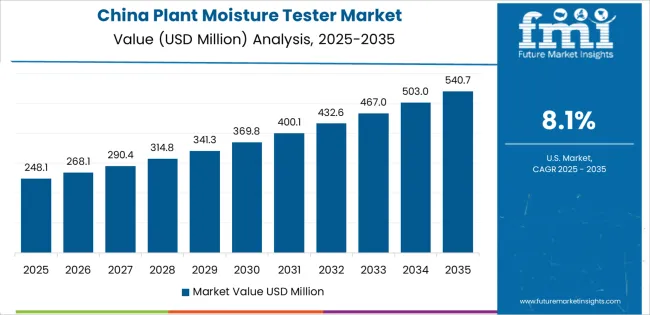
The Chinese market emphasizes advanced measurement features, including precision data control and integration with comprehensive agricultural monitoring platforms that manage irrigation optimization, crop health assessment, and environmental applications through unified monitoring systems. The country demonstrates strong growth at 8.1% CAGR, driven by agricultural modernization expansion, precision farming initiatives, and emerging environmental research development that support moisture tester integration. Chinese agricultural researchers prioritize operational effectiveness with plant moisture testers delivering consistent measurement accuracy through advanced sensor capabilities and field adaptation features.
Technology deployment channels include major agricultural universities, specialized research institutes, and government agricultural programs that support professional applications for complex crop monitoring and environmental assessment applications. Monitoring platform integration capabilities with established farming systems expand market appeal across diverse operational requirements seeking precision agriculture and sustainability benefits. The expanding agricultural sector and accelerating precision farming adoption create steady demand, while innovative applications in greenhouse cultivation and smart agriculture open new growth avenues.
Performance Metrics:
Germany's advanced agricultural research market demonstrates sophisticated moisture tester deployment with documented operational effectiveness in precision farming applications and environmental monitoring facilities through integration with existing sensor systems and research infrastructure. The country leverages engineering expertise in agricultural technology and monitoring systems integration to maintain strong growth at 6.9% CAGR. Research centers, including facilities in Munich, Berlin, and Stuttgart, showcase premium installations where moisture tester systems integrate with comprehensive agricultural platforms and environmental management systems to optimize crop production and monitoring effectiveness.
German agricultural researchers prioritize system accuracy and EU compliance in instrument development, creating demand for precision measurement systems with advanced features, including wireless connectivity and automated data logging systems. The market benefits from established agricultural research infrastructure and a willingness to invest in precision farming technologies that provide long-term agricultural benefits and compliance with international environmental and quality standards.
Market Intelligence Brief:
The USA market demonstrates sophisticated deployment across precision agriculture applications with documented effectiveness in crop monitoring and environmental research facilities through integration with comprehensive farm management systems and ecofriendly agriculture infrastructure. The country leverages advanced agricultural capabilities in farming innovation and environmental monitoring technologies to maintain moderate growth at 5.7% CAGR. Research centers, including facilities in California, Iowa, and Texas, showcase premium installations where moisture tester systems integrate with comprehensive agricultural platforms and irrigation management networks to optimize crop productivity and water efficiency.
American agricultural researchers prioritize measurement accuracy and operational efficiency in instrument development, creating demand for innovative testing systems with advanced features, including smartphone integration and cloud data platforms. The market benefits from established precision agriculture infrastructure and willingness to invest in monitoring technologies that provide long-term agricultural benefits and compliance with USDA and environmental standards.
Market Intelligence Brief:
The UK market demonstrates advanced sustainability deployment with documented operational effectiveness in environmental monitoring applications and agricultural research facilities through integration with existing conservation systems and research infrastructure. The country leverages regulatory expertise in ecofriendly agriculture and monitoring systems integration to maintain steady growth at 5.1% CAGR. Research centers, including facilities in Cambridge, Edinburgh, and Oxford, showcase premium installations where moisture tester systems integrate with comprehensive environmental platforms and agricultural management systems to optimize conservation compliance and monitoring effectiveness.
British agricultural researchers prioritize system sustainability and regulatory compliance in instrument development, creating demand for certified measurement systems with advanced features, including long-term data tracking and environmental impact assessment. The market benefits from established agricultural research infrastructure and commitment to invest in monitoring technologies that provide long-term environmental benefits and compliance with UK and EU agricultural standards. Organic farming applications, ecofriendly agriculture systems, and environmental conservation programs drive diversified demand across multiple application segments.
Strategic Market Indicators:
India's market demonstrates rapid expansion deployment with documented operational effectiveness in agricultural modernization applications and precision farming facilities through integration with emerging irrigation systems and crop management infrastructure. The country leverages growing agricultural capabilities in farming technology and monitoring systems integration to achieve high growth at 7.5% CAGR. Agricultural regions, including Maharashtra, Punjab, and Karnataka, showcase expanding installations where moisture tester systems integrate with comprehensive farming platforms and water management networks to optimize agricultural productivity and resource efficiency.
Indian agricultural researchers prioritize operational affordability and measurement reliability in instrument development, creating demand for cost-effective testing systems with essential features, including battery operation and durable field construction. The market benefits from expanding agricultural modernization infrastructure and willingness to invest in affordable monitoring technologies that provide productivity improvements and compliance with domestic agricultural standards.
Market Intelligence Brief:
Japan's market demonstrates precision deployment with documented operational effectiveness in advanced agricultural applications and horticultural research facilities through integration with sophisticated monitoring systems and quality control infrastructure. The country leverages engineering excellence in precision agriculture and monitoring systems integration to maintain steady growth at 4.5% CAGR. Research centers, including facilities in Tokyo, Kyoto, and Osaka, showcase premium installations where moisture tester systems integrate with comprehensive quality platforms and environmental control systems to optimize crop excellence and monitoring effectiveness.
Japanese agricultural researchers prioritize system precision and measurement excellence in instrument development, creating demand for ultra-premium testing systems with advanced features, including micro-precision sensors and automated calibration systems. The market benefits from established horticultural research infrastructure and commitment to invest in highest-quality monitoring technologies that provide superior agricultural positioning and compliance with stringent Japanese quality standards.
Strategic Market Indicators:
Brazil's market demonstrates expanding deployment with documented operational effectiveness in large-scale agricultural applications and environmental monitoring facilities through integration with modern farming systems and irrigation infrastructure. The country leverages agricultural capabilities in commercial farming and environmental monitoring to maintain strong growth at 6.3% CAGR. Agricultural regions, including São Paulo, Minas Gerais, and Paraná, showcase growing installations where moisture tester systems integrate with comprehensive farm management platforms and water conservation networks to optimize crop productivity and resource management.
Brazilian agricultural researchers prioritize operational durability and field reliability in instrument development, creating demand for robust testing systems with practical features, including weather-resistant construction and extended battery operation. The market benefits from expanding commercial agriculture infrastructure and willingness to invest in monitoring technologies that provide productivity improvements and compliance with agricultural export standards.
Market Intelligence Brief:
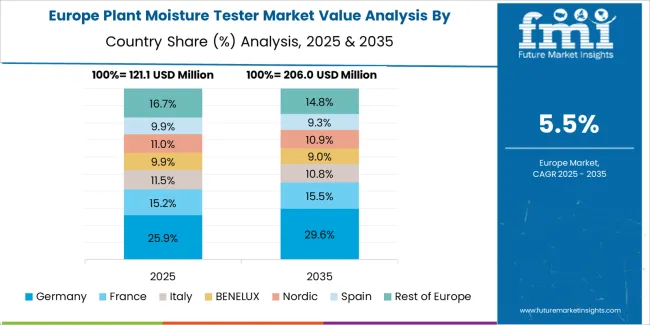
The plant moisture tester market in Europe is projected to grow substantially over the forecast period, with Germany expected to maintain its leadership position with a significant market share supported by its advanced agricultural research infrastructure and major technology centers in Munich and Berlin. The United Kingdom follows with strong market presence, driven by comprehensive environmental monitoring programs and precision agriculture initiatives. France holds substantial market share through specialized agricultural research activities, ecofriendly farming applications, and horticultural production. Italy commands notable market presence through strong agricultural technology projects.
Spain accounts for growing market share aided by greenhouse cultivation expansion and precision agriculture adoption. The Netherlands maintains steady share driven by specialty horticulture applications and advanced greenhouse monitoring demand. The Rest of Europe region is anticipated to show steady adoption, reflecting consistent growth in Nordic countries, precision agriculture expansion in Central European markets, and environmental monitoring upgrades across Eastern European agricultural facilities.

In Japan, the market prioritizes single parameter instrument systems, which capture the dominant share of agricultural and horticultural installations due to their advanced features, including precision measurement accuracy optimization and seamless integration with existing research infrastructure. Japanese agricultural researchers emphasize reliability, precision, and long-term operational excellence, creating demand for single parameter systems that provide consistent monitoring capabilities and superior sensor performance based on research requirements and quality standards. Multiparameter instruments maintain secondary positions primarily in advanced environmental research applications and comprehensive agricultural monitoring installations where multifunctional measurement capability meets operational requirements without compromising data accuracy.
Market Characteristics:
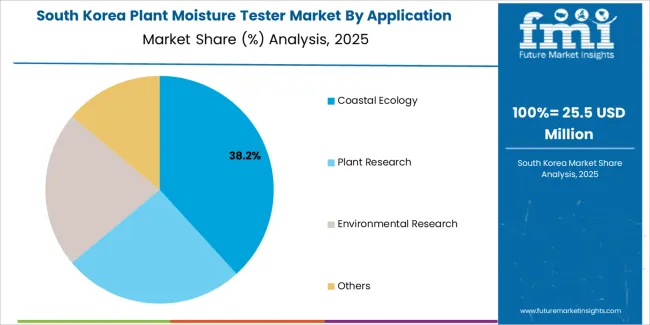
In South Korea, the market structure favors international instrument manufacturers, including SONKIR, VIVOSUN, and Extenuating Threads, which maintain dominant positions through comprehensive product portfolios and established agricultural research networks supporting both precision farming and environmental monitoring installations. These providers offer integrated solutions combining advanced moisture tester systems with professional technical services and ongoing calibration support that appeal to Korean agricultural researchers seeking reliable measurement systems.
Local agricultural distributors and specialty retailers capture moderate market share by providing localized service capabilities and competitive pricing for standard agricultural monitoring installations, while domestic manufacturers focus on specialized applications and cost-effective solutions tailored to Korean agricultural market characteristics.
Channel Insights:
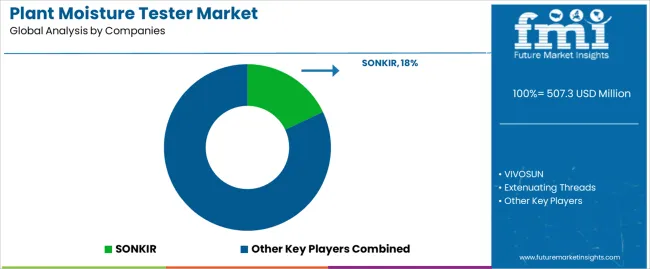
The market operates with moderate concentration, featuring approximately 15-18 meaningful participants, where leading companies control roughly 40-45% of the global market share through established agricultural research relationships and comprehensive moisture testing portfolios. Competition emphasizes advanced measurement capabilities, sensor accuracy, and agricultural monitoring integration rather than price-based rivalry. The leading company, SONKIR, commands approximately 18.0% market share through its extensive precision measurement product line and global agricultural market presence.
Market Leaders encompass SONKIR, VIVOSUN, and Extenuating Threads, which maintain competitive advantages through extensive agricultural technology expertise, global distribution networks, and comprehensive measurement integration capabilities that create customer loyalty and support competitive pricing. These companies leverage decades of sensor technology experience and ongoing innovation investments to develop advanced moisture testing systems with precision accuracy control and durability features. Technology Innovators include Luster Leaf, XLUX, and Dr. Meter, which compete through specialized sensor formulation technology focus and innovative measurement capabilities that appeal to agricultural researchers seeking advanced testing solutions and data reliability.
These companies differentiate through rapid product development cycles and specialized precision agriculture application focus. Regional Specialists feature instrument manufacturers focusing on specific geographic markets and specialized applications, including portable testing systems and integrated agricultural monitoring solutions. Market dynamics favor participants that combine reliable sensor formulations with advanced measurement capabilities, including precision accuracy control and automatic calibration optimization features. Competitive pressure intensifies as traditional agricultural equipment suppliers expand into moisture testing systems, while specialized environmental monitoring companies challenge established players through innovative sensor solutions and wireless platforms targeting precision farming and coastal ecology segments.
| Item | Value |
|---|---|
| Quantitative Units | USD 507.3 million |
| Measurement Type | Single Parameter Instruments, Multiparameter Instruments |
| Application | Coastal Ecology, Plant Research, Environmental Research, Others |
| Regions Covered | Asia Pacific, Europe, North America, Latin America, Middle East & Africa |
| Countries Covered | China, India, Germany, Brazil, United States, United Kingdom, Japan, and 20+ additional countries |
| Key Companies Profiled | SONKIR, VIVOSUN, Extenuating Threads, Luster Leaf, XLUX, Dr. Meter, Kensizer, TEKCOPLUS, REOTEMP |
| Additional Attributes | Dollar sales by measurement type and application categories, regional adoption trends across Asia Pacific, Europe, and North America, competitive landscape with instrument manufacturers and agricultural technology suppliers, researcher preferences for measurement accuracy and portability, integration with agricultural monitoring platforms and environmental data collection systems, innovations in sensor formulations and wireless connectivity, and development of automated calibration solutions with enhanced performance and field durability capabilities. |
The global plant moisture tester market is estimated to be valued at USD 507.3 million in 2025.
The market size for the plant moisture tester market is projected to reach USD 908.5 million by 2035.
The plant moisture tester market is expected to grow at a 6.0% CAGR between 2025 and 2035.
The key product types in plant moisture tester market are single parameter instruments and multiparameter instruments.
In terms of application, coastal ecology segment to command 37.9% share in the plant moisture tester market in 2025.






Full Research Suite comprises of:
Market outlook & trends analysis
Interviews & case studies
Strategic recommendations
Vendor profiles & capabilities analysis
5-year forecasts
8 regions and 60+ country-level data splits
Market segment data splits
12 months of continuous data updates
DELIVERED AS:
PDF EXCEL ONLINE
Plant Genome Extraction Kit Market Size and Share Forecast Outlook 2025 to 2035
Plant Derived Analgesics Market Size and Share Forecast Outlook 2025 to 2035
Plant Based Beverage Market Forecast and Outlook 2025 to 2035
Plant-based Body Paint Pigments Market Size and Share Forecast Outlook 2025 to 2035
Plant Based Plastic Market Forecast and Outlook 2025 to 2035
Plant Stem Cell Encapsulation Market Analysis - Size and Share Forecast Outlook 2025 to 2035
Plant Stem Cell Skincare Product Market Size and Share Forecast Outlook 2025 to 2035
Plant-based Cheese Market Size and Share Forecast Outlook 2025 to 2035
Plant Based Meat Packaging Market Size and Share Forecast Outlook 2025 to 2035
Plant Sterol Supplements Market Size and Share Forecast Outlook 2025 to 2035
Plant Protein Hydrolysate Market Size and Share Forecast Outlook 2025 to 2035
Plant Asset Management Market Size and Share Forecast Outlook 2025 to 2035
Plant-Derived Hyaluronic Acid Alternatives Market Analysis - Size, Share, and Forecast Outlook 2025 to 2035
Plant Peptides Market Size and Share Forecast Outlook 2025 to 2035
Plant-Based Foam Market Size and Share Forecast Outlook 2025 to 2035
Planting Machinery Market Size and Share Forecast Outlook 2025 to 2035
Plant-based Snacks Market Analysis - Size, Share, and Forecast Outlook 2025 to 2035
Plant Based Meals Market Size and Share Forecast Outlook 2025 to 2035
Plant-Derived Ceramide Alternatives Market Analysis - Size and Share Forecast Outlook 2025 to 2035
Plant-Based Squalane Market Analysis - Size and Share Forecast Outlook 2025 to 2035

Thank you!
You will receive an email from our Business Development Manager. Please be sure to check your SPAM/JUNK folder too.
Chat With
MaRIA